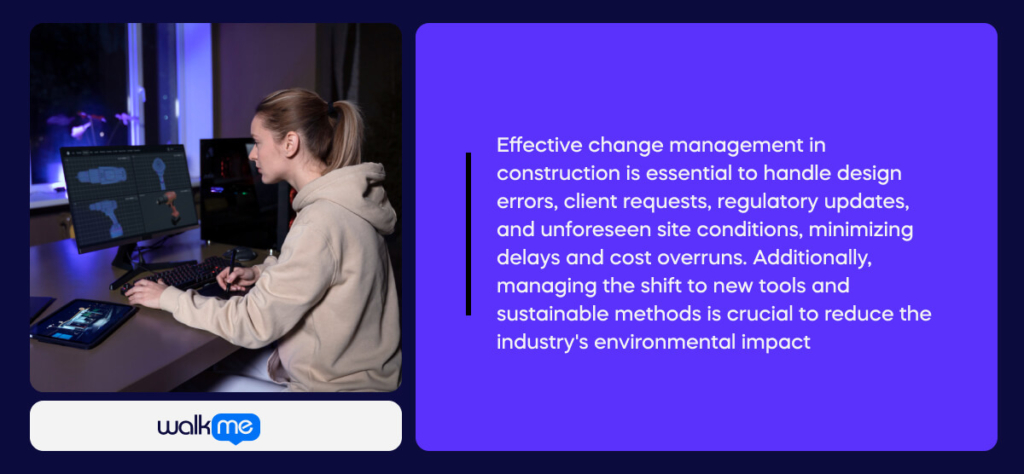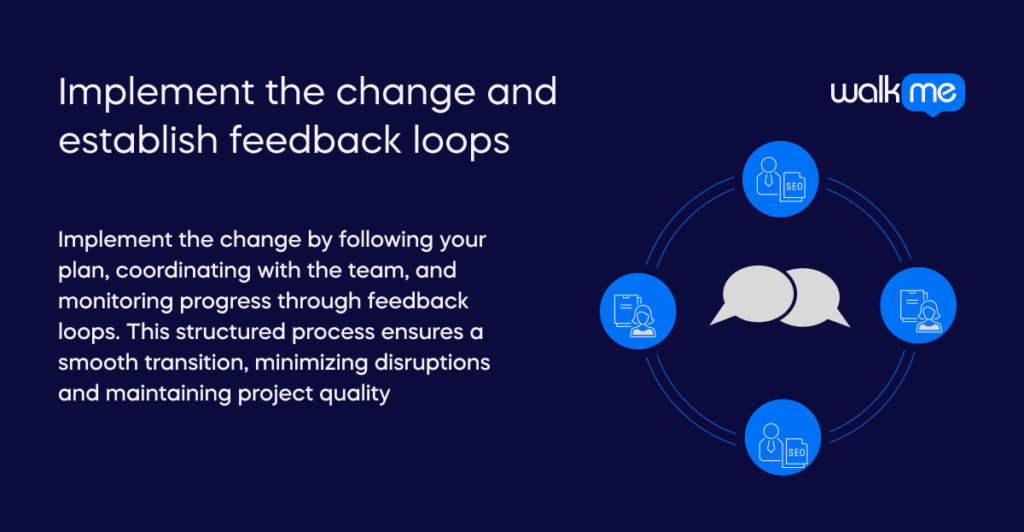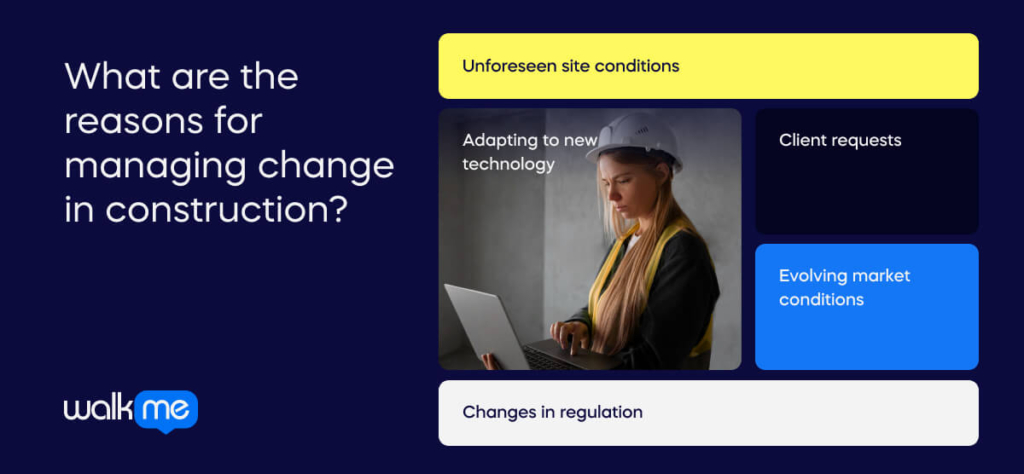From business education, new technology has transformed the way we work over the past decade. And while the construction industry may not appear tech-savvy at first glance, the sector hasn’t been immune to these changes either.
According to a report by The Entrepreneur, technology has transformed the construction sector. It’s replaced manual processes with full automation.
In today’s world, shovels and spades aren’t the only tools available on construction sites. Forbes reports modeling, virtual reality, 3D printing, drones, and other advanced tech are now key to construction.
New tools, workplace culture changes, and a shift to environmentalism have forced the construction industry to adapt. However, making change work is hard. A McKinsey report suggests that up to 70% of change initiatives fail.
Construction leaders need to lay the groundwork to keep the bricks laying. They must grasp the importance of change management and know how to do it well in ever-changing markets.
What is change management in construction?

Change management in construction is a structured process. It manages and makes changes to a construction project. It encompasses handling changes to the project’s scope, design, specifications, schedule, and other aspects that may arise during construction.
This structured approach ensures that changes are carefully assessed, documented, approved, and integrated into the project seamlessly to minimize disruptions and maintain project quality and efficiency.
Why is change management in construction important?

Effective change management in construction is crucial for ensuring project success. It keeps the wheels, bricks, shovels, and workforce of a construction project moving smoothly.
Project change management includes several steps: preparation, assessment, design, implementation, and monitoring. These steps help handle changes to project scope, schedule, cost, and other factors.
Effective change management helps a project adapt to changing client preferences, site conditions, or unexpected events. By managing changes proactively, projects can optimize costs, reduce delays, and stay within budget, ultimately leading to happier clients and partners.
What are the types of changes in construction?
There are various types of changes in construction. Here are a few of the most common:
- Design changes: These occur when the project design is altered, such as the layout or the materials used.
- Scope changes: These changes happen when the project’s scope is modified. This can include additions, deletions, or alterations to the work or specs.
- Schedule changes: These occur when the project schedule is adjusted, such as by extending or reducing the timeline.
- Cost Changes: These occur when the project budget is modified. This includes adding or removing items that affect the cost.
- Contractual Changes: This change happens when adapting to a new contract change. This includes altering the payment terms or obligations.
- Regulatory Changes: These changes happen when construction projects need to follow new rules. These could include stricter requirements for safety and worker protection.
- Unforeseen Changes: This occurs when a construction project needs to adapt to surprises. These include budget cuts, workforce changes, and other external events.
How to manage change in construction in six steps
Knowing the types of changes in construction is helpful, but it’s also key to understanding how to make changes well.
Here’s how to manage change in construction in six steps:
- Identify and evaluate changes
Start by identifying and evaluating the impact of change management on your project.
For example, ask yourself: What is the need for the change? How long will it take to implement? Are there any particular challenges or obstacles that may arise?
The first step is to identify the need for change, whether in the design, schedule, cost, or other aspects.
This forms the foundation for successful change management in construction. Evaluating the feasibility of the changes is important, as this will be invaluable when seeking approval.
- Apply for approval of changes
Depending on the nature of your changes, you may need to seek approval first. Construction projects in the US and many other parts of the world can be logistically complicated. The process can be bureaucratic, often requiring approval from local governments, external bodies, and other relevant authorities.
According to a LinkedIn post by GreenLite Technologies, the approval process can take as long as three years, depending on the circumstances of the project. However, with prior preparation, it can be easier to pass.
During this stage, it’s important to ensure your documentation is standardized. Properly format all documents. These include change order requests, proposals, and logs. This will reduce errors and speed up reviews and approvals.
- Develop a comprehensive change plan
Once your proposed change has been approved, it’s important to develop a comprehensive plan. First, create a clear and consistent process for evaluating changes.
This should include templates for documenting change requests to ensure all proposals are considered based on their impact on schedule, budget, and project goals.
Next, find the potential effects of changes. This includes their impact on engineering, procurement, construction, and start-up. This ensures that all parties understand the implications of the change.
It’s also best to plan for the implementation and support of new software. Ensure that employees are informed and trained to maximize adoption and minimize disruption.
- Communicate change across the construction team
Change management in construction is only possible if everyone is on board. Research shows that effective communication is crucial for successful change management.
Establish clear communication channels, involve everyone, and leverage digital tools to effectively communicate changes across a construction team. It’s best to start by creating a culture of openness and transparency. Then, adapt communication styles to fit various situations.
This can be done by asking coworkers to provide constructive feedback, reflecting on and learning from each project, and implementing change order management software to automate workflows and reduce errors.
Create templates for documenting change requests to standardize the format and ensure all necessary information is included. By following these strategies, construction teams can provide seamless communication and minimize the impact of changes on project quality.
- Implement the change and establish feedback loops

Once the roadmap is established, the project is approved, and the workforce has been communicated with, it’s time to implement the change.
This is the most crucial step and requires diligent analysis. Follow your detailed plan, considering schedule, resource, and procurement adjustments. Coordinate with the project team and subcontractors through clear communication, collaborative planning, and role clarification.
To ensure success, continuously monitor the implementation and address any issues promptly. This can be done through feedback loops and surveys. Ensure your feedback loops identify areas for improvement and document lessons learned.
Although change implementation can be unpredictable, this structured process should ensure a smooth and effective transition. By evaluating each stage, you can minimize disruptions, maintain project quality, and ensure client satisfaction.
- Conduct a final review
To conduct a final review of change management in construction, document all changes made during the project, including reasons, scopes, costs, and schedule implications.
Evaluate the overall impact of changes on the project, identifying any deviations from the original plan. Document lessons learned to improve future project execution. Review the change control process, identifying areas for improvement.
Finally, the results should be communicated to stakeholders, including the client, project team, and subcontractors. This thorough review assesses the change process and finds ways to improve future projects.
What are the reasons for managing change in construction?

There are many reasons why change management in construction is needed. While each project is unique, here are the most common reasons for managing change in construction:
Unforeseen site conditions
Adapting to unexpected site conditions is a common challenge in construction projects. Effective change management helps teams quickly respond to these conditions, ensuring adjustments are made without significantly disrupting the project timeline or budget.
Adapting to new technology
The construction industry is evolving with the integration of digital technologies. Change management helps construction firms adapt to technological advancements, ensuring a smooth transition to new tools and methodologies.
Client requests
Client requests for changes during a project are common. Effective change management ensures client expectations are managed and alterations are communicated and executed to enhance overall satisfaction.
Evolving market conditions
Market conditions can significantly impact project costs. Effective change management ensures that modifications are implemented while maintaining budget constraints.
Changes in regulation
Construction projects must adhere to rigorous regulatory standards, building codes, and safety requirements. Change management ensures that alterations align with regulatory compliance, preventing legal issues and delays in project approvals.
What are the best practices for managing change in construction?

Managing change in construction is challenging. However, following these best practices will ensure that your change process goes smoothly.
Create a change management roadmap for each project life cycle
Change management roadmaps facilitate clear and timely communication among stakeholders, ensuring everyone is informed and aligned. This improves collaboration and morale across the workforce, increasing engagement. A roadmap is also clear and transparent. This cuts the risk of misunderstandings and disputes.
This leads to better decision-making by those overseeing the change. By identifying potential changes early, project teams can make informed decisions and minimize the impact of changes on the project.
Set expectations for building a culture of change
Successful change management in construction hinges on the workforce culture. It’s important to ensure that all stakeholders in the change process are well-informed, engaged, and feel valued. To effectively build a culture focused on change, start by clearly understanding the need for change.
Setting clear expectations ensures that all stakeholders comprehend the implemented changes, reducing misunderstandings and miscommunications. Focusing on a culture that fosters communication is key.
A study of 235 employees examined the effects of organizational change communication, finding that meaningful communication significantly influenced employee engagement and job satisfaction.
Additionally, it’s best to focus on alignment across the workforce. Clear expectations help align stakeholders’ goals and efforts. They ensure everyone is working towards the same objectives. Transparency is also crucial. Setting clear expectations promotes transparency, enabling stakeholders to understand the rationale behind changes and their impact on the project.
Implement new technology
Implementing new technology is crucial for change management in construction. Like many sectors, construction is going through a digital transformation. New technologies improve efficiency, communication, accuracy, and decision-making. They also boost safety, collaboration, transparency, customer satisfaction, and cost-cutting.
They provide a competitive advantage by enabling construction companies to stay ahead of the curve and deliver projects more efficiently and effectively.
Common tools used in the construction industry include building information modeling software, project management software, document management systems, and digital collaboration platforms.
Focus on long-term sustainability and green construction
When implementing change management in construction, it’s important to prioritize long-term and sustainable solutions.
For example, constructing buildings that minimize environmental impact and promote eco-friendliness involves using materials and techniques that reduce energy consumption, water usage, and waste generation.
Green construction focuses on using renewable resources, such as solar and wind power, as well as features like green roofs and rainwater systems. This approach is key. It will reduce the construction industry’s large greenhouse gas emissions and help it move toward a more sustainable future.
Green construction isn’t going anywhere. It’s likely to remain a key factor in the US construction industry. According to a recent report, the green building market in the US reached over $83 billion in 2021, up from $69.5 billion in 2017.
What are the benefits of managing change in construction?
There are countless benefits to managing change in construction. Here are a few:
Improved cost control
Effective change management helps control costs by evaluating the impact of proposed changes on the project budget, identifying potential cost overruns, and managing additional expenses associated with changes.
Enhanced scheduling
Change management plays a crucial role in maintaining project schedules by evaluating the impact of changes on the project timeline, resources, and critical path activities. This ensures seamless integration of changes into the existing project schedule.
Greater client satisfaction
Effective change management enhances the reputation of construction firms by delivering projects on time, within budget, and to the required quality standards. This leads to increased client satisfaction and repeat business.
Minimized conflicts
Effective change management reduces the likelihood of disputes and claims arising from unapproved changes or unclear documentation by providing clear communication, transparent processes, and documented approvals.
Increased transparency, accountability, and adaptability
Construction change management provides transparency into project progress, costs, and timelines, ensuring that stakeholders are well-informed and aligned throughout the project lifecycle.
It also helps construction firms adapt to technological advancements, regulatory changes, and market fluctuations, ensuring projects are delivered efficiently and effectively. This adaptability is crucial for maintaining competitiveness and meeting evolving industry standards.
What are the challenges of managing change in construction?

Despite the benefits, there are challenges, too. Here are some of the main challenges that those managing change should be aware of:
Resistance to change
Frequent changes without proper management pose a significant challenge in the construction industry, leading to various issues. Among these, resistance to change is particularly concerning, as it can impact employee morale and behavior.
Effectively managing the human element of change is essential for construction projects. This approach helps maintain morale, enhance collaboration, and ensure smooth change implementation without disrupting overall productivity and efficiency.
Decreased morale and productivity
Frequent changes without proper management can lead to confusion, resistance, and a decline in productivity. This can be a significant challenge when managing change in construction.
Change leaders should be aware of this hurdle and make adjustments accordingly. For instance, those managing the change should focus on improving company culture and assess the morale of the workforce through surveys and one-on-one meetings.
The issue of decreased morale and productivity isn’t just impacting the construction industry. According to a recent report by The Washington Post, employers in the US are seeing a puzzling decline in worker productivity, which some experts attribute to the “quiet quitting” trend where employees do the bare minimum.
Communication and training issues
Effective communication is crucial for managing changes in construction, yet it can be hindered by language barriers, cultural differences, and resistance to change. Language barriers and cultural differences pose challenges. They can lead to misunderstandings during change.
Inadequate training can lead to improper change implementation, causing delays and cost overruns in construction projects with multiple stakeholders.
Regulatory compliance and delays
When regulations change, it can suddenly impact a project already in progress, necessitating a change order to ensure compliance with the new requirements. Changes that expand the original construction plan can extend the project timeline, particularly if they involve specialty contractors.
Additionally, the time required to obtain approvals for these changes and adjust project plans can further delay the schedule. Strategic planning can help contractors manage additional work effectively to mitigate significant delays.
Safety concerns
Safety concerns pose a significant challenge for change management in construction due to the industry’s inherent risks. Changes to a construction project can introduce new hazards, potentially increasing the risk of accidents and compromising worker safety.
Effective change management involves identifying and mitigating these risks. It requires ensuring that workers are informed about the changes and equipped with the necessary safety measures.
This includes providing comprehensive training, conducting regular safety audits, and implementing stringent safety protocols to prevent accidents and maintain regulatory compliance.
Laying the brickwork: Why change management in construction is key
Effective change management is crucial in the construction industry. The industry is complex and constantly changing. Changes can arise for many reasons.
These include design errors, client requests, regulatory updates, and unforeseen site conditions. Failing to manage these changes can lead to significant project delays, cost overruns, and disputes.
New tools have ushered in a new era of construction. The field has moved from shovels to drones and spades to 3D printing. Now, more than ever, it’s crucial to manage this change effectively and ensure that the workforce can use these new tools well.
It’s important to note that the construction industry has a significant environmental impact. Recent research indicates that the construction and use of buildings in the US contribute to 39% of the country’s total greenhouse gas emissions.
Moving forward, sector leaders will need to adapt to more sustainable methods. This shift will require diligent change management to mitigate environmental impact and contribute to saving our planet.

